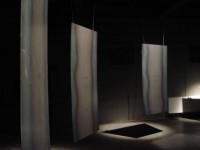CHRISTOPH DE BOECK
timecodematter installation
source: vimeo
In 2005 the first sound performance in the ‘time code matter’ series opens at Concertgebouw, Bruges (Belgium). The aim of the sound artists Christoph De Boeck and Yves De Mey is to stress the tangible aspect of sound in a setting that is both intimate and monumental. In the second ‘time code matter’ production (2007) they use steel resonance to create a strong physical and emotional impact.
.
.
.
.
.
.
source: deepbluebe
Christoph De Boeck approaches sound as a visual and tactile medium. In his installations sound turns out to be a tangible presence. The spatial organisation of sound sources, the choice of materials in media and the method for sound transmission all are part of De Boeck’s permanent research into how sound relates to an environment and to human presence. The dynamic spatialisation of sound confronts the visitor with the idea of acoustic energy as an artistic object and even as a visual principle.
In the surroundings of a huge immersive bamboo scenography De Boeck launches microscopic audiostructures into wireless headphones for a ‘swarm’ of 40 spectators in the collaborative work ‘closer’ (deepblue, 2003). The sound objects are projected in between the spectator’s ears and the physical space is acoustically denied. In 2005 spatial characteristics determine shape and dynamics of sound layers and events when a 10-channel sound set-up transforms the main concert hall of Concertgebouw in Bruges into an large reverb chamber behind the backs of the on-stage seated audience (‘time code matter I’, with Yves De Mey). De Boeck looks for yet another form of spatiality with the application of transducers on solid media. Disembodied electronic sound is reintegrated into heavy materials, like the resonating sheets of steel in ‘timecodematter’ (2007), as well an interactive installation (solo work) as a concert (‘time code matter II’, in collaboration with Yves De Mey).
Christoph De Boeck is also co-artistic director of Deepblue, an interdisciplinary production structure. Within this structure he has written, in collaboration with Heine Avdal and Yukiko Shinozaki, concepts for performances and he developed spatialised installations for data and audio for those performances. Their most known work is ‘you are here’ (2008), which distributes objects and text amongst spectators by means of archive boxes.
Recently, in collaboration with research centre IMEC, the interactive installation ‘Staalhemel’ (‘Steel Sky’, 2009) was opened. This responsive environment links up the resonance of steel plates with a realtime measurement of the visitor’s brainwaves. In this project there is no more audio playback; all spatial sound originates from 80 pins hitting a matrix of steel segments mechanically. The patterns of impact represent fluctuations in the brain activity of the visitor.
.
.
.
.
.
.
.
source: youtube
In the interactive installation timecodematter the visitor enters an arena that is bordered with vibrating sheets of massive steel. The steel objects are pulsating with low frequencies and they react to the approach of persons. The acoustic energy in this installation is both penetrating and intangible: the resonant properties of twelve different steel sheets respond to the low frequencies and produce a conjuring effect.
Christoph De Boeck is part of the production structure ‘deepblue’.


